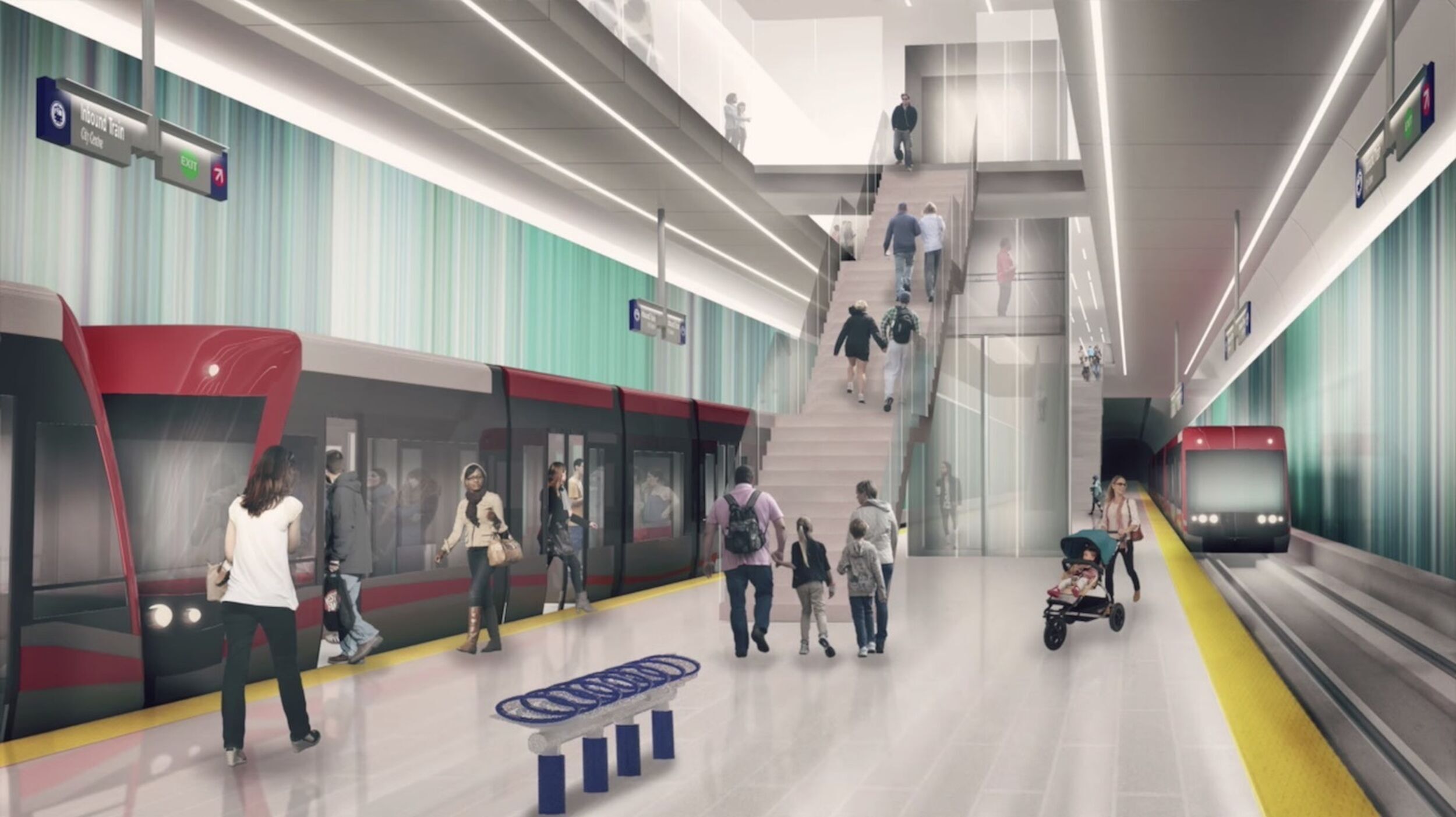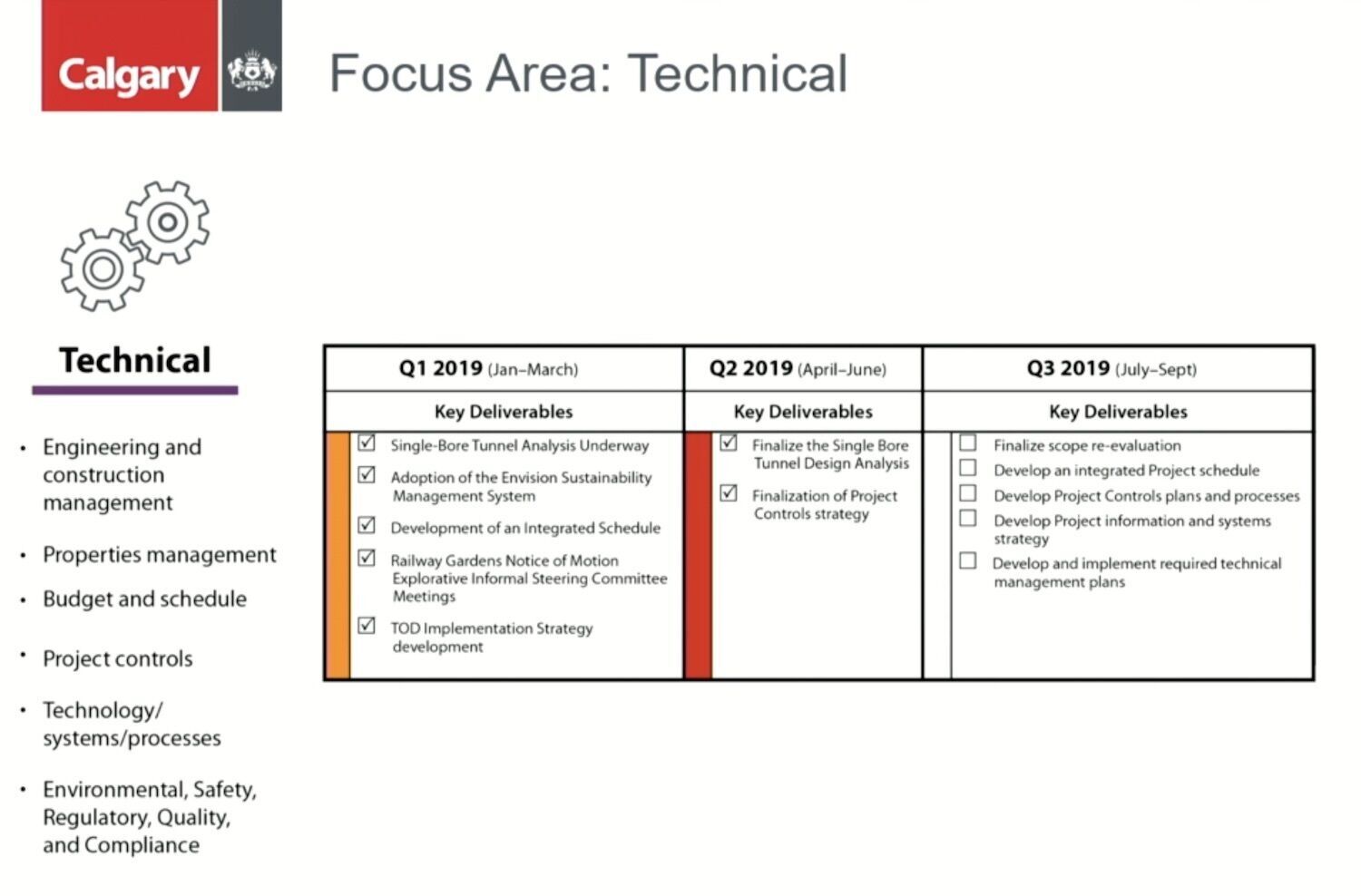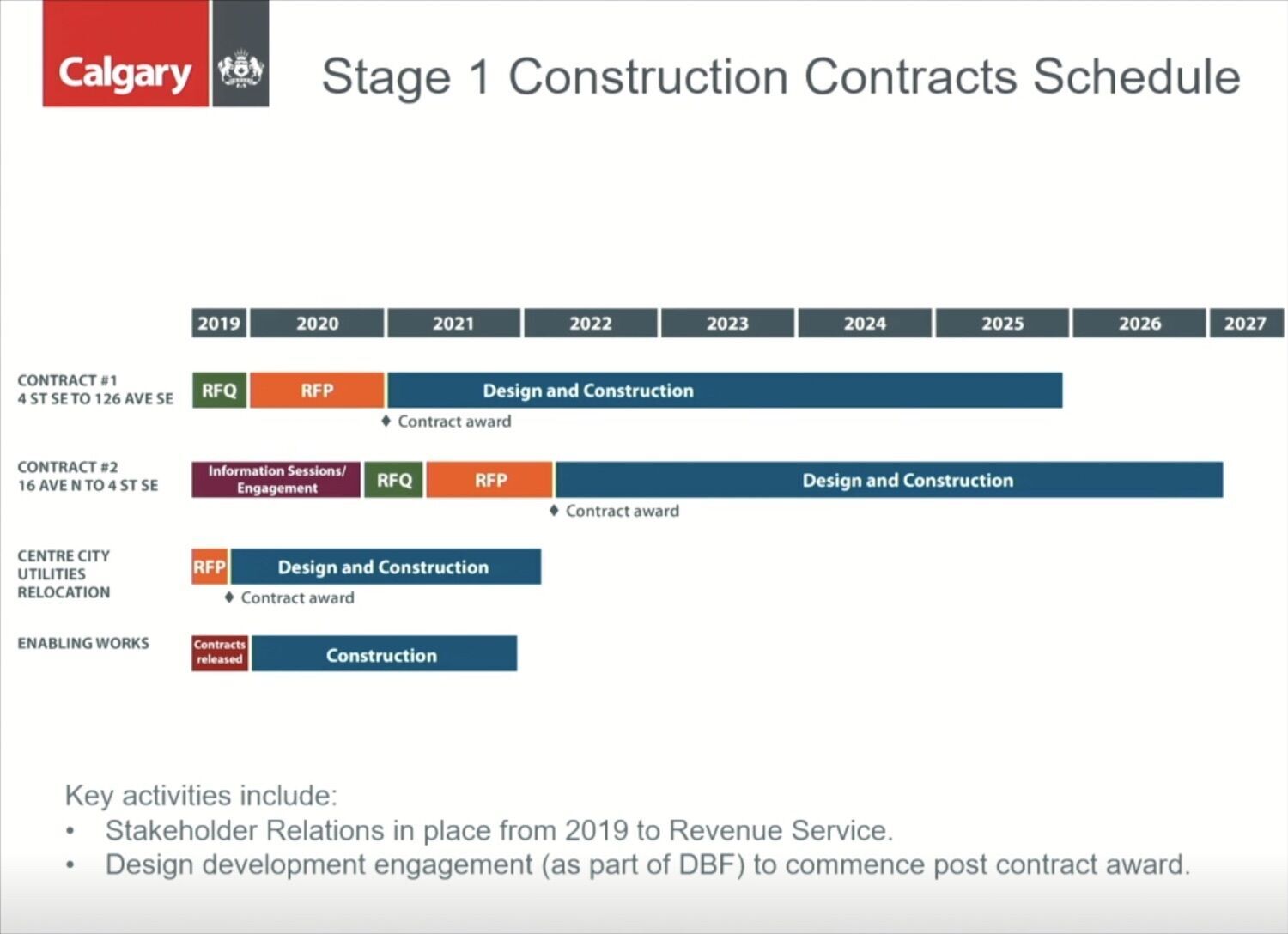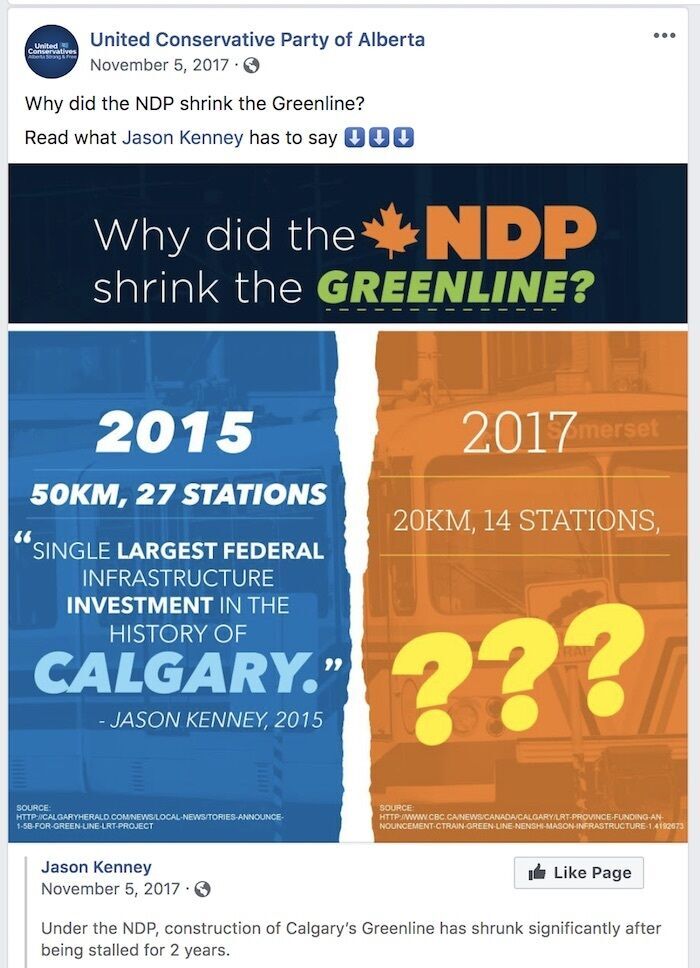
Rendering of an underground Green Line station. (City of Calgary)
Sprawlcast Ep 18: Green Line revisited (Part 1)
UCP-connected heavyweights push for a pause.
Support in-depth Calgary journalism.
Sign Me Up!We connect Calgarians with their city through in-depth, curiosity-driven journalism—but can't do this alone! We rely on our readers and listeners to fund our work. Join us by becoming a Sprawl member today!
Is Calgary's Green Line being derailed? City admin is now wary of tunnelling under downtown. Meanwhile, a group of well-connected businessmen are lobbying to halt the project. And Premier Jason Kenney continues to cast doubt on the project's soundness and scope. We take a closer look at what's going on.
A full transcript of the episode is below.
COUNCILLOR SHANE KEATING: Let's move, and let's move now.
COUNCILLOR DRUH FARRELL: And I want to assure you that I care as much about financial risk as you do.
COUNCILLOR EVAN WOOLLEY: I cannot support beginning construction on a train from Ramsay to a maintenance facility.
JEREMY: Those were a few Calgary city councillors speaking about the Green Line. Here we are at the start of summer, and things have gotten really hot on this file very quickly. All of a sudden, there's talk of, hmm, should we be doing this the way we planned? And even: should we be halting work on this project altogether?
The Sprawl is in the middle of a climate action edition – that's our current pop-up – and obviously, the Green Line is a big part of taking on climate change in Calgary. It's no secret that this city has been designed for the car, and transit has kind of come as an afterthought. The car is king, and we continue to build new communities on the city's edges that are car dependent. So how do you turn things around in the middle of a climate crisis? Well, the City intends to – at least on paper. And the Green Line is a big piece of that.
Let’s move on the project, because we did all of this and it seems like we’re back to that point again.
The Green Line is going to be going before city council on July 22nd, and that's going to be a big meeting, so we're going to look at what's happened in the last few weeks, why it's happening, and also look at the politics behind what's going on.
But first, a very quick Green Line refresher. Eventually, it's going to run 46 km from far north-central Calgary to the deep southeast, but that's going to happen eventually – that's not happening right away. Stage one is what's going to be built over the next seven to eight years, and that's going to run from 16th Ave in the north, going south and underground through downtown and the Beltline, and then into the southeast, ending at Shepard.
At least, that was the plan.
Our story starts in the last week of June – last week of school, summer is about to begin, and City administration indicates that they're thinking of making some big changes to how they build the Green Line.
PETER OLIVER: I'd have to say we were blindsided by this.
JEREMY: This is Peter Oliver with the Beltline Neighbourhoods Association, and his group was one of the many groups that were involved before city council approved the final Green Line alignment. That was in June 2017 that they made that decision – two years ago.
OLIVER: And so that's when things, as far as we were concerned and the City was concerned, were set in stone. Well, now they're not set in stone, and everything in the downtown and the Beltline seems up for reconsideration now.
JEREMY: This came out at city council's transportation committee meeting on June 26th.
Fabiola MacIntyre is the Deputy Director of the Green Line team at the City, and she put up a slide that said that the technical aspects of the project had gone from medium risk to high risk.

FABIOLA MACINTYRE: This is the one category that has gone from an orange to a red. I want to pause on this one, because it's important to tell you today that we're at a key point in our project and at a point of where we need to pivot. The technical risks that we're identifying are of significance. The central city is very complex, but it's also representative 4 kilometres of 20. So we've got 16 ready to go, but the 4 kilometres are very challenging.
JEREMY: At issue is the tunnel that's supposed to go under the Bow River and under downtown.
This is Michael Thompson, GM of the City's Transportation Department.
MICHAEL THOMPSON: We believe that the risks of going underneath the river with the tunnel that we were looking at, and the station construction we were looking at, are too great.
We need to pivot. The technical risks that we’re identifying are of significance.
JEREMY: So here's what City admin proposes: They say instead of doing this project as just one big contract, let's break it into two. Let's go ahead with the southeast part of the project, and then spend more time figuring out the downtown part that's giving us headaches.
MACINTYRE: That time affords us the ability to start our conversations with Calgarians to talk about the highest value in terms of the central city, and how the investment in the central city – and what works and what doesn't, and we need to reengage with Calgarians to make sure that we are committed to delivering this project on time and on budget, and so that means that we do need to re-examine – and we have been re-examining, so it's just a continuation.
We just have not been in a position to have conversations based on our technical information, because they were confidential at the time. We were still doing our investigation. But we are at a point where we're ready to do that, and we'll be out to the communities.

JEREMY: They plan to do that starting this month. But then, this Transportation Committee meeting took a very interesting turn as a group of four businessmen took to the podium.
JIM GRAY: First of all, we represent a group of about 50 Calgarians – professional people, construction people, businesspeople, others – that just came together.
JEREMY: This is Jim Gray: oilman, philanthropist, and a long-time supporter of conservative parties – both provincial and federal. He's in his 80s now, and he talked about how his group has been meeting with the City Manager and several councillors about the Green Line.
GRAY: We're very grateful for that. It's been a very positive experience, and what we're hoping to do is to put a little cement on the bricks today and carry this forward.
So let me get straight to what our recommendations and conclusions are. We respectfully submit that the economic consequence of this project, stage one, as planned, embodies an unacceptable high risk of becoming an economic catastrophe – and I use that word appropriately – for the city at this time.
And we urge that all spending on the project as currently planned be immediately halted, that we immediately approach the federal and provincial governments and we ask to confirm their funding of $1.5 billion each, should the City decide to suspend and take a pause in the project for one year in order to study various lower-cost capital in operating and lower-risk alternatives to the plan.
We urge that all spending on the project as currently planned be immediately halted.
JEREMY: Jim Gray's group has major clout. These are people with tremendous wealth, power, and influence in our city, and they have a lot of pull in the world of conservative politics. The Green Line, obviously, is a municipal project, so what does it have to do with provincial politics? Well – quite a lot, actually, because Premier Jason Kenney has repeatedly called into question the scope of the Green Line and its value.
Here's Kenney speaking to reporters in March.
KENNEY: I would just point out that when I was a federal minister, I announced a-billion-and-a-half dollars for Calgary's LRT Green Line in the spring of 2015 without a federal carbon tax, and did so two years before the NDP finally matched that commitment.
And by the way, when I made that commitment – it was for an LRT that would be about 40 km long, with 20 stations serving the far north and the far southeast – the NDP came in with a carbon tax; two-year delay; a-billion-and-a-half dollars to get us half as much track, half as many communities served. I can't think of a better example of the fiscal incompetence of the NDP than their mismanagement of the Green Line.
JEREMY: This was a talking point that Kenney and the UCP used repeatedly: that the NDP had somehow cut the Green Line in half.

JEREMY: The only thing is, it's not true. City council had already made the decision to do the shortened amount for phase one – before the NDP announced its share of the funding two years ago during Stampede. And the shortened phase one was due, in large part, to the decision to tunnel under downtown, which is more expensive.
The budget for stage one is just under $5 billion.
JEFF BINKS: The vision that we developed two years ago, and that was approved by city council, was shaped by the engagement of over 10,000 Calgarians over multiple years.
JEREMY: That's Jeff Binks with the group LRT on the Green. That group was very involved with those consultations a few years ago, and what came out of it was: Let's not repeat the mistakes of the past, like we did on 7th Avenue with the CTrain. Let's spend the money, put this in the ground, and build it for future generations – not just the cheapest way possible.
So all of that had been decided by the time the NDP stepped up and said, we're going to fund our portion of the Green Line. But hey – why bother with facts when you can blame everything on the carbon tax, right?
The vision approved by city council was shaped by the engagement of over 10,000 Calgarians over multiple years.
JEREMY: Anyway – let's go back to that council committee meeting. Jim Gray was joined by three other people.
BRIAN FELESKY: Let's have a formal pause.
JEREMY: This is Brian Felesky – elite Calgary lawyer, businessman, another prominent Calgary conservative. He's given almost $100,000 to conservative parties federally and provincially since the 1990s, including over $9,000 to Jason Kenney's provincial conservative leadership campaigns in 2017.
The third person at the podium was Barry Lester, and he's a former Stantec VP who has worked on a number of big projects in Calgary.
BARRY LESTER: I've been involved in the Saddledome and the speed-skating oval. I was the engineer responsible for the Stoney Trail bridge across the Bow River.
JEREMY: The fourth person was Steve Allan, and he's Chair of Calgary Economic Development.
STEVE ALLAN: We had our annual general meeting – and I think you were all there – and we talked about advocacy and working with people from the community, with citizens. And I think we are in a very unique position to do that and bring the concerns of the community and business leaders to council in a constructive and collaborative manner.
JEREMY: Steve Allan is moving on to bigger and better things. A week after this meeting, Premier Jason Kenney announced that Allan is going to be the commissioner of the public inquiry into environmental groups that dare criticize the Alberta oil and gas industry. And with this new role, he's going to be stepping down as Chair of Calgary Economic Development in the fall.
Okay, so that's who was at the podium. Let's listen in to some of what they had to say to city councillors.
Let’s drop tools on tunnelling and examine in detail other efficient, effective alternatives.
GRAY: If we stumble on this, it'll take this city down – not just fiscally, but our reputation will be lost.
LESTER: With respect to underground construction in downtown Calgary, there are some huge issues... When Bankers Hall was built, they encountered enormous amounts of groundwater – more than they could pump – and in fact, they had to abandon the lowest level of the parking structure. 9th Avenue settled, the utilities in 9th Avenue moved, and an awful lot of remedial work was necessary to solve that problem.
FELESKY: Let's have a formal pause. Let's drop tools on tunnelling and examine in detail other efficient, effective alternatives. And you might say, well, aren't we doing that anyway?
But we're saying to you, there would be great comfort and great solace to the community – and, based on experience, great comfort and great solace in the psychological difference, between going on and considering risks, and stopping to have a full, wholesale re-examination of those risks.
JEREMY: The group is worried that the project will be $2 billion over budget, but it's not just the financial risks that they raised concerns about. They also raised concerns about ridership numbers and the alignment.
LESTER: The other consideration that I think should be looked at now – because the city is very different than it was when Green Line was initiated – is the route selection through downtown. 2nd Street is a great route, but it causes the line to have to kick back to the east when it reaches 9th or 10th Avenue. An alignment that goes just east of City Hall, down 3rd Street east, would cut 1 km of construction – 1 km of length – out of the line.
GRAY: We're not opposed to the Green Line. We're not trying to terminate the program. This is a huge undertaking, and once it gets started, we can't stop it; and Calgary is in distress, so we have to be particularly diligent, we have to be very courageous, we have to look at every detail.
Do you actually believe that administration would move forward with this project without the analysis that you’re talking about?
JEREMY: The group called for a pause on the project for a year, and they suggested things like elevating the train line in the downtown in order to save money and avoid risk. Now, keep in mind City admin had just suggested something similar: They don't want to tunnel under the river, and they're looking for ways to shorten the tunnel as much as possible and bring as much of the line to the surface as possible through the downtown and the Beltline.
After the businessmen did their presentation, Councillor Druh Farrell had some questions.
COUNCILLOR DRUH FARRELL: With a project of this magnitude, the risk assessment that you're speaking about is what we do. So do you actually believe that administration would move forward with this project without the analysis that you're talking about? Do you actually believe that?
LESTER: That's obviously a very good question, and as I said, when I stood up here I felt very uncomfortable second-guessing Mr. Thompson's department and his people, [microphone noise] who I feel are very good people.
JEREMY: This is one of the annoying things about this particular meeting. The microphone in council chambers was going haywire, so I have to edit some stuff out here to spare your ears, but Barry Lester said that even though there are good people in the Transportation Department, there are still cost efficiencies –
LESTER: … that I believe should be pursued, and obviously council would be the decision-maker on whether or not those opportunities are followed or not.
FARRELL: Yes, and to reassure you, that work is occurring – so, administration is examining their assumptions, looking at the studies …
COUNCILLOR JEFF DAVISON: Councillor Farrell, do you have a question?
JEREMY: In the background there is Councillor Jeff Davison.
FARRELL: I do. I do have a question. So, administration is looking at those things, and that would be their duty, so I have full faith in them that they will bring in the expertise necessary in order to make an informed decision.
Did you … We heard from many, many downtown office building owners – ones that have the biggest assets in the city of Calgary – and did you engage with them? We heard extensively from them.
GRAY: Our … I don't work for, but I work with, Brookfield, and actually, how I got started on all of this is when we built the underground parking at the new Brookfield building, and they've had all kinds of issues that they've had to deal with as they go through. What has driven our interest, Councillor Farrell, is the enormous fiscal risk associated with this project at this time in Calgary's history. We just can't move forward with that.
JEREMY: At this point, Farrell reiterates her question about whether or not the group engaged with owners of business buildings downtown.
FARRELL: We have. And so any changes to the project – and we're exploring all options. I tell you, I wouldn't be supportive of an above-grade elevated train in our downtown, nor would almost every office building owner in the downtown. So we've engaged with them, and going forward, we will need to engage with them again if there are any changes. That's a commitment that we've made as a council, because this is a major public investment.
I have a final question, then. So, many of you were advocates for very large projects. The Olympics, the arena, and the BMO Centre far exceed the budget of the Green Line. Did you bring –
DAVISON: Chair, this is not before us.
FARRELL: No, I'm asking –
DAVISON: Let's get to questions. This is not a question of debate. Let's get questions out for these gentlemen.
FARRELL: I will ask my question. It's related. I'm just wondering, and some of them – the Olympics is an example – very high risk.
JEREMY: Here, the microphone goes haywire again, but Councillor Farrell asks: Why didn't you bring forward those same concerns at that time? Now Councillor Jeff Davison jumps in. He says: The Olympics is not before us. Let it go.
The Olympics is not before us. Let it go.
DAVISON: It is not before us. They are here talking about the Green Line. Please address your questions to the Green Line and not in relation to the Olympics.
FARRELL: It's the same group. It's the same group. I'm just wondering.
KEATING: It doesn't matter. The same group – we do need to address –
DAVISON: Again, you are drawing a conclusion –
FARRELL: Excuse me, Mr. Davison.
DAVISON: … and making a characterization. If you have a question –
KEATING: Councillor Davison – please, let me chair.
JEREMY: This is Councillor Shane Keating, who's chairing the meeting.
KEATING: The Olympics is not debatable. Risk is. So you can ask a question about, specifically, risks, and that's all.
FARRELL: Okay. And that is really the crux of this question: is high-risk endeavour that you advocated for – you did not bring up similar concerns. Why?
ALLAN: I was an advocate for the Olympics …
JEREMY: This is Steve Allan – remember, he's Chair of Calgary Economic Development.
ALLAN: I did contemplate and consider risks, and I thought that they were well mitigated within the proposal. With respect to this matter, I accept that City administration has been working away on this. We've been having a lot of dialogue, as has been referred to, but the risks – you know, until yesterday, when it became clear that maybe we would pause on this, there was no definitive answer to that particular question, and so it was still an open issue on risk.
And with Jim and the group that he brought forward and that I have been part of, I'm a simple accountant – all I understand is cost. I understand cost overruns, and I understand risk, and that, to me, is a very significant issue. So to me, in my own mind, whether I'm associated with Calgary Economic Development or just a citizen who cares about our city, I contemplated risk in both situations, and this one is, at this moment, unresolved.
I did contemplate and consider risks, and I thought that they were well mitigated within the [Calgary 2026 Olympic bid] proposal.
FELESKY: And just a footnote of the alignment with downtown businesses and downtown buildings, we have a number of people on our committee who are part, directly or indirectly, with that constituency. There is no question in our mind that, aesthetically, it would be very nice to have underground service for the Green Line in the downtown area.
Functionally, however, if it was going to cost us an extra $2 billion for the city, unequivocally, every senior leader in this city would say: No. Stop.
FARRELL: Do you think we should ask them? That is my question. So, yes, that will be our obligation. And I want to assure you that I care as much about financial risk as you do, so we will be looking at the financial risk moving forward with this project. Thank you.
JEREMY: Councillors asked some more questions, and then they went in camera, as they do – in other words, behind closed doors – and when they came out … well, let's listen in to what they had to say.
We're going to hear Councillor Gian-Carlo Carra, followed by Councillor Davison, and then Councillor George Chahal.
COUNCILLOR GIAN-CARLO CARRA: I have consistently had concerns about elements of the project. I have concerns about elements of the project, but I know that through the design process we get there. What has never wavered for me is the existential question that this is an absolutely fundamental, essential thing, and we have the money in the bank to build a piece of infrastructure that will serve – that will be a backbone for our city for the next hundred years. So I think voting for this is essential.
Public transit provides equity amongst Calgarians.
DAVISON: And we're doing this at a time when, yeah, budgets are constrained, but costs are also lower. And, again, I get back to the idea of, we're trying to deliver something with a vision here, so I'm very happy to see the continued level of rigour and due diligence that's being done on the file. I hope we continue that. I think when we split things out looking at the 80/20, if we were to wait to a hundred percent of every cost assurance and every risk, we would never get anything done.
COUNCILLOR GEORGE CHAHAL: Public transit provides equity amongst Calgarians. It's important that we … There's going to be challenges and ups and downs along the way, but we, I think, are making the prudent steps today to ensure that the risks are being looked at where they are occurring, and we need to proceed at certain legs of this project, which makes sense to avoid further cost escalations, and inflation that could occur over time, as well, competing with other projects, and the support from other orders of government, which is extremely important, which have supported this project, so I'm happy to support this.
JEREMY: Councillor Jyoti Gondek brought up P3s, which are public-private partnerships – in essence, partially privatizing the project. We're going to hear Councillor Gondek, followed by Councillor Evan Woolley, and then Councillor Shane Keating, to close.
COUNCILLOR JYOTI GONDEK: One of the things that I think is important is to recognize that P3s sometimes allow you to have innovation, and they allow you to distribute risk effectively between the partners that are at the table, so I don't have an issue with what's being proposed in terms of which part of phase one moves first and which one takes a little time. I don't disagree with this approach, and I think allowing for more time for that RFP for that critical 4 km gives us potential cost efficiency and innovation options that we might not have if we move forward with that right away.
P3s sometimes allow you to have innovation, and they allow you to distribute risk effectively between the partners at the table.
COUNCILLOR EVAN WOOLLEY: Separating the contracts in two makes sense if you know what each product is. My support for the Green Line was always based on how this thing was going to roll through the downtown, and so starting work on one piece without knowing what the product that is the most important to the city, I just cannot – I just can't get behind it. I cannot support beginning construction on a train from Ramsay to a maintenance facility.
KEATING: Going down 3rd Street would have been effective if it was a freight train, because you don't have to serve any individuals. We don't do that here. So a lot of the stuff we heard today was business cases for, let's get this thing done for as fast and as quick and as cheap as we can, but what happened to all the Beltline service? What happened to the service to the west side of the core of the city? How do you integrate all of that into a plan that says, "Do it this way, because, boy, you could avoid the whole core and away you go." It doesn't make sense, so what we have to do is make sure that we are continuing to offer that service, and I think that's what the Green Line does.
My concern is – and if we look at the timeline – you know, the project timeline, and we look at what we originally came – when are we actually going to get started to give that service if we don't move forward today? And the farther and the more we debate some of the issues – the issues that we have to give kudos and credit to the committee …
JEREMY: Here, Councillor Keating gave a shout out to the Green Line team.
KEATING: They have been delving into every topic we talked about for months and months. This isn't brand-new. It didn't happen this weekend. I mean, we didn't have this new recommendation because people talked to us on Friday. It's been going on for an awful long time, and we have to give them credit for making sure that they're doing those things, but we have to get to the point – this is a project for service, and I have talked many times before about city shaping. We went through that whole process.
The most engaged project we've had in history came to a point where we have to get into a project, and let's move on the project, because we did all of this and it seems like we're back to that point again, is, all of a sudden, let's go through this. So I do have reservations about what's here. I won't vote against it, but I am very, very concerned; and will be very, very vocal that, let's move, and let's move now.
JEREMY: After this meeting, once again, Premier Jason Kenney cast doubt on the scope and soundness of this project. He said he was happy to hear about the businessmen making their pitch to council. He told the Star: "I'm glad that we have some eminent Calgarians and people at council."
My support for the Green Line was always based on how this thing was going to roll through the downtown.
Meanwhile, Councillor Evan Woolley surprised almost everyone by announcing that he is going to be putting forward a Notice of Motion calling for a pause on the project.
WOOLLEY: I am not interested in building a project that sucks and doesn't serve Calgarians. I would rather not do the Green Line than do a crappy Green Line.
JEREMY: We're going to hear more from Councillor Woolley on part two of this Green Line Sprawlcast. Thanks for listening, and see you shortly for part two.
Support in-depth Calgary journalism.
Sign Me Up!We connect Calgarians with their city through in-depth, curiosity-driven journalism—but can't do this alone! We rely on our readers and listeners to fund our work. Join us by becoming a Sprawl member today!

